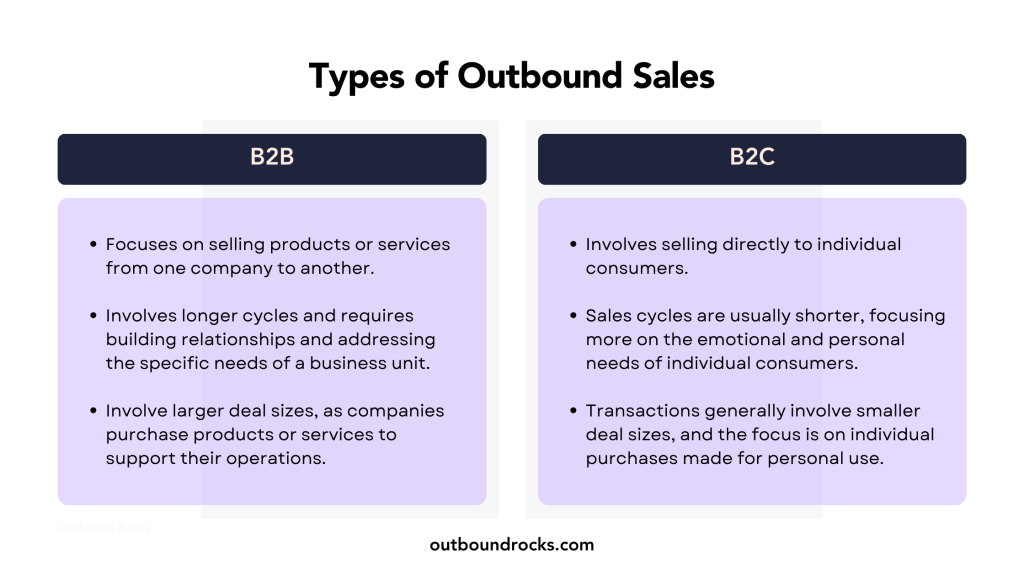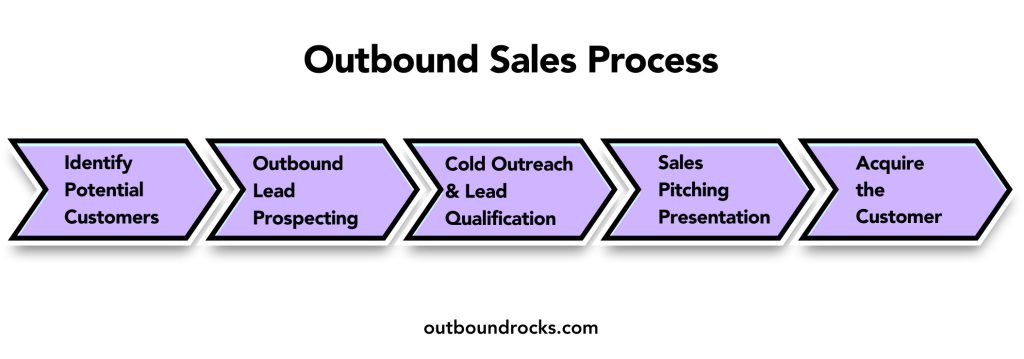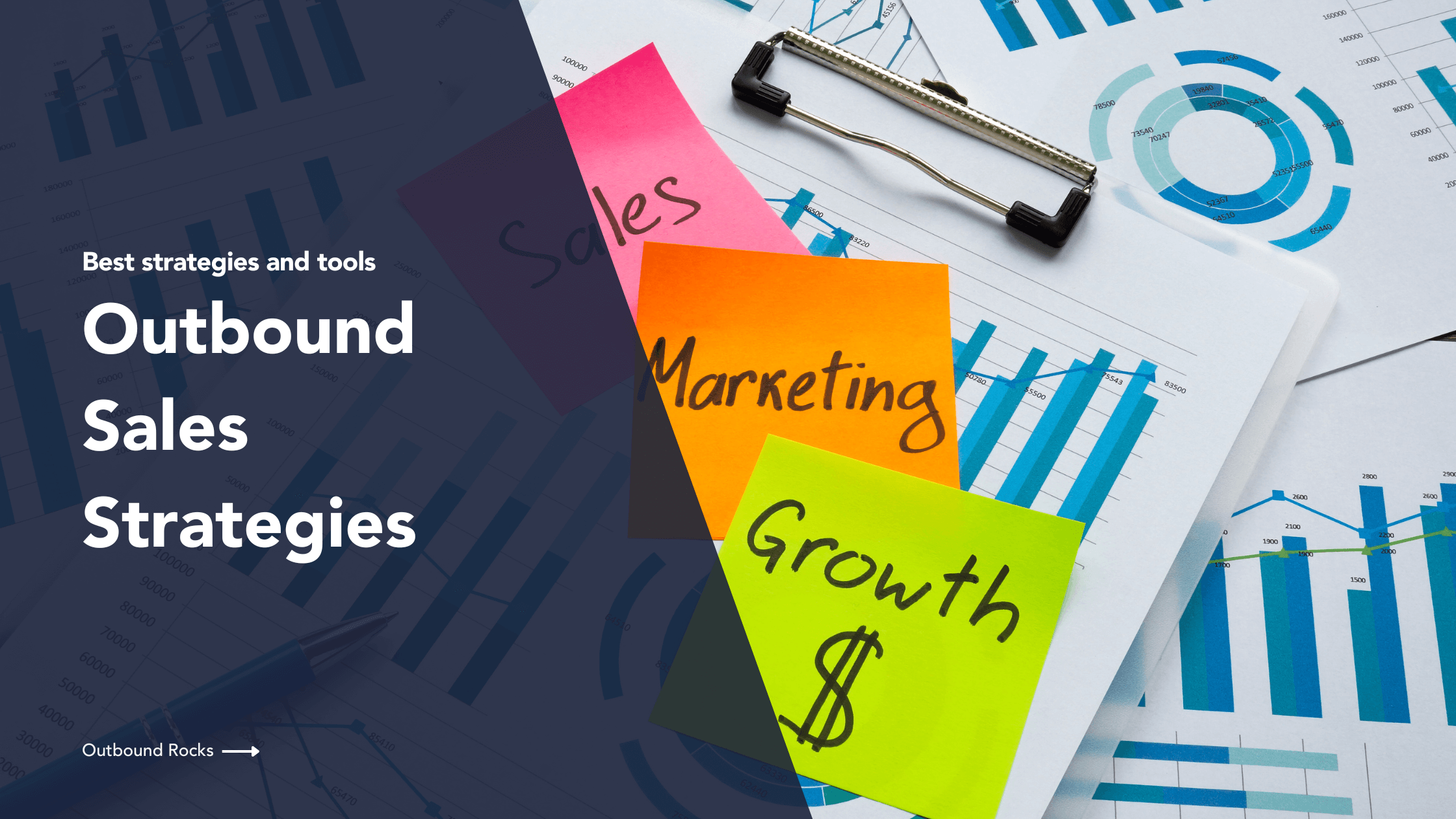In the dynamic world of sales, outbound strategies represent a powerful and proactive approach to reaching prospects.
Unlike inbound sales, where customers initiate contact, outbound sales involves the sales team actively reaching out to prospects.
In this article, we will talk about outbound sales and explore its many benefits, different types, processes, techniques, tools and effective tips to increase your success in closing deals.
TABLE OF CONTENTS
– What is Outbound Sales?
– Inbound vs. Outbound Sales
– Key Benefits of Outbound Sales
– Types of Outbound Sales
– Outbound Sales Process
– Top Outbound Sales Techniques
– Outbound Sales Tips
– Outbound Strategy with Outbound Rocks
What is Outbound Sales?
An outbound sales strategy is a proactive approach in which sales professionals initiate contact with potential customers.
In contrast to inbound sales, where customers reach out to the company, outbound sales requires the active pursuit of leads through various outreach methods.
The goal of this strategy is to engage with prospects, generate interest, and ultimately convert them into customers.
Inbound vs. Outbound Sales
Deciding whether to use an outbound or inbound strategy depends on a number of factors, including your industry, audience, and goals.
For example, if your business needs immediate leads or has a smaller customer base, outbound strategies such as cold calling or direct outreach may be more effective.
On the other hand, if the goal is to build long-term relationships with a larger audience, inbound strategies can attract and engage prospects over time.
To help you understand, we’ve summarized the key differences in the table below.
| Aspects | Inbound Sales | Outbound Sales |
| Approach | Passive: Draws prospects in by creating valuable content. | Active: Initiates contact with prospects through outreach. |
| Audience Engagement | Focuses on attracting and engaging a broader audience. | Targets specific, often pre-qualified leads or prospects. |
| Lead Generation | Generates leads gradually through content and SEO efforts. | Creates immediate leads through direct outreach methods. |
| Cost | Lower cost per lead due to content creation and SEO. | Higher cost per lead due to direct outreach and advertising. |
| Relationship Building | Long-term relationship building through informative content. | Focuses on immediate interactions, less emphasis on nurturing. |
Key Benefits of Outbound Sales
Now that we’ve shown the key differences between inbound and outbound strategies and outlined their approaches, let’s talk about the key benefits of outbound sales.
Here is a list of the key benefits with examples:
1. Targeted outreach
Outbound sales allows companies to proactively target specific demographics or ideal customer profiles that are more likely to be interested in the product or service being offered, potentially leading to higher conversion rates.
For example: a software company that specializes in email marketing tools determines that its ideal customers are mid-sized businesses looking for efficient automation solutions. Using outbound sales, the company’s sales team targets these specific businesses, focusing their efforts on industries or locations where such solutions are in high demand.
2. Sales process control
Sales reps can actively track leads, manage the pace of interactions, and tailor their approach to individual prospects, resulting in more personalized and strategic engagement.
For example: sales reps at a telecommunications company engage with prospects through cold calls and targeted emails at a pace that matches their sales strategy.
3. Lead generation
Whether through cold calls, emails, or other direct outreach methods, companies can quickly acquire leads and initiate conversations to accelerate the sales cycle.
For example: a marketing agency launches an outbound email campaign offering a free digital marketing strategy consultation. Within hours of sending the email blast , they receive numerous inquiries, generating immediate leads for the sales team to follow up on and convert into prospects.
4. Opportunity for direct engagement
Sales reps can address specific questions, provide detailed information, and guide prospects through the sales process, potentially leading to faster decisions and conversions.
For example: a solar panel installation company leverages outbound sales by going directly to homeowners in areas known for high sun exposure. Through door-to-door sales, the company’s representatives engage directly with homeowners, providing detailed information that facilitates immediate interaction and potential sales.
5. Scalability
Outbound sales strategies often offer a more straightforward path to scalability. As the business grows, it becomes easier to expand outreach efforts and replicate successful sales processes across a larger team or broader market.
For example: a startup offering a personalized meal delivery service starts with a small outbound sales team focused on one city. As the company gains traction and receives positive responses from initial outreach, it aims to scale operations to cover multiple cities.
Types of Outbound Sales
In general, there are two types of outbound sales and these are its main characteristics:
B2B Outbound Sales
Involves a sales approach focused on addressing the specific needs and challenges of companies.
The sales process often requires a more consultative and educational approach as it involves selling products or services that have a direct impact on the efficiency, productivity, or profitability of the buying organization.
B2B sales often involve larger deals and contracts because they address the needs of an entire business unit rather than individual consumers.
B2C Outbound Sales
The sales approach in B2C outbound sales focuses on appealing to the emotions and desires of individual consumers, addressing their personal needs, and highlighting the immediate benefits or satisfaction that the product or service can provide.
These transactions typically involve smaller deal sizes and are more driven by consumer behavior, preferences, and the need for personal satisfaction or lifestyle enhancement.

Outbound Sales Process
Do you sell to a customer or to another company? Whether you are a B2B or B2C company, if you want to implement an outbound strategy, you need to follow these 5 steps.
1. Identify your prospects
The process starts with identifying potential customers. This involves creating an ideal customer profile or buyer persona by analyzing demographics, behaviors, and needs.
Understanding the specific characteristics of your target audience helps you focus your efforts on those most likely to benefit from your product or service.
2. Outbound lead prospecting
Once prospects are identified, outbound lead prospecting comes into play. This step involves the systematic search and discovery of leads that match the defined ideal customer profile. Using a variety of tools and databases, sales teams search for and gather information on potential leads in order to build a targeted list for outreach.
3. Cold outreach & Lead qualification
After lead prospecting, the outbound sales process moves to cold outreach. This step involves initiating contact with potential leads through methods such as cold calling, personalized emails, or direct messaging. The goal is to engage leads, introduce the product or service, and assess their level of interest and fit through lead qualification.
4. Sales pitch
Once qualified leads show interest or potential, the sales pitch stage begins. Sales reps present the value proposition of the product or service, emphasizing how it solves the specific pain points or needs identified in the previous stages.
The goal is to demonstrate the benefits and convince leads that the offering is the solution they need.
5. Acquire the customer
The final step in the outbound sales process is to close the deal and acquire the customer. This step includes negotiating terms, addressing any concerns or objections, and finalizing the sale.
Once the deal is closed, it marks the successful acquisition of a new customer. In addition, maintaining ongoing customer relationships and ensuring customer satisfaction after the acquisition is critical to customer retention and potential future sales.

Top Outbound Sales Techniques
Outbound sales is all about making the first move and reaching out to your prospects.
But…do you know how to make that first move?
Most sales professionals swear by 4 effective outbound sales techniques to increase conversions and revenue:
- Cold Calling: in this classic outbound strategy, salespeople call prospects, introduce the product or service, and try to generate interest or set up a meeting.
- Email Campaigns: outbound sales through email campaigns involves sending targeted and personalized emails to prospects with the goal of engaging them with compelling content, offers, or information about the company’s products or services.
- Direct Mail: sending physical mail, such as brochures, catalogs, or promotional materials, directly to potential customers’ addresses as a means to capture their attention and interest.
- Social Selling: use social media platforms to connect with prospects, engage in conversations, and share valuable content or insights to build relationships and generate interest in the company’s offerings.
Outbound Sales Tips
a) Tailored communications
Personalizing your communications is key. Tailor your message to the specific needs and pain points of the prospect.
Addressing their concerns directly and demonstrating how your product or service can solve their particular challenges greatly increases the chances of closing the deal.
b) Active listening
Listen carefully to your prospects. Understanding their needs and challenges is critical to providing a solution that fits.
Active listening allows you to understand their pain points and tailor your pitch accordingly, fostering a stronger connection and making the prospect feel understood.
3) Follow up persistently
Persistence is key, but balance it with tact. Follow up with prospects consistently, but avoid being overly pushy.
Sending timely, valuable information or reminders can keep you on their radar without being intrusive.
The goal is to stay top of mind without being annoying, thereby increasing the chances of closing the deal when the prospect is ready.
4) Focus on value and benefits
Shift the focus from listing product features to demonstrating the value and benefits of your offering.
Highlight how your offering directly impacts the prospect’s business or personal life.
Demonstrating the tangible benefits and value they will gain by choosing your product or service can significantly influence their decision-making process.
5) Handle objections gracefully
Anticipate and handle objections gracefully. Understand potential concerns or objections that may arise and be prepared to handle them effectively.
Respond with confidence and offer solutions or clarifications that put the prospect at ease. Addressing objections thoughtfully can alleviate doubts and move the deal closer to closing.
How to complement your outbound strategy with Outbound Rocks
At OutboundRocks, we provide an all-in-one customer acquisition system for small and medium-sized businesses.
Our focus is to empower your Sales Development Representatives (SDRs) and Sales Reps by providing a technology-driven ally that automates the process of discovering opportunities and closing deals.
At OutboundRocks, we offer:
- Lead Generation
- Analytics tool
- Integration with CRMs
Join us at Outbound Rocks and discover the power of a comprehensive outbound system designed to optimize your sales funnel, connect with ideal prospects, and seamlessly integrate with your CRM for a holistic sales approach.
